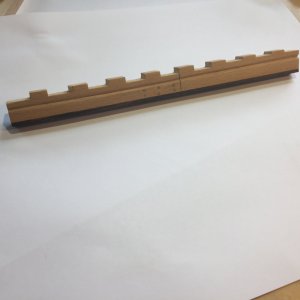-

Win a Free Custom Engraved Brass Coin!!!
As a way to introduce our brass coins to the community, we will raffle off a free coin during the month of August. Follow link ABOVE for instructions for entering.
-

PRE-ORDER SHIPS IN SCALE TODAY!
The beloved Ships in Scale Magazine is back and charting a new course for 2026!
Discover new skills, new techniques, and new inspirations in every issue.
NOTE THAT OUR FIRST ISSUE WILL BE JAN/FEB 2026
- Home
- Forums
- Ships of Scale Group Builds and Projects
- Group Build Archives
- Blandford Cross Section PoF Group Build
You are using an out of date browser. It may not display this or other websites correctly.
You should upgrade or use an alternative browser.
You should upgrade or use an alternative browser.
DocBlake's HMS Blandford Cross Section Build - 1/32 Scale - [COMPLETED BUILD]
Your keel is looking very good, very accurate and exact.....
Thanks, Mike!
This is kind of crazy but let me explain what I did to "blacken" the copper bolts in the keel. I first tried "painting the exposed copper with Jax Black and Brass Black. The black residue that formed bled into the surrounding wood and made a mess. I sanded back to bare wood and metal and tried again. I tried painting the copper flat black, but the results were not uniformly round, and the paint looked terrible. Sanded to bare wood and copper again. The I saw something on the internet!
Hard boil, cool and peel 2 eggs. Chop up the eggs and break up the shells and layer them on the bottom of a plastic container with a tight fitting top. Secure the keel to the top with bread bag ties so the part isn't sitting on the eggs. Wait over night. You can see the results in the photo. I did put a coat of poly over the blackening so that I don't damage it or rub it off somehow. The bolts still look like metal - but used and oxidized metal! It's the sulfur in the eggs!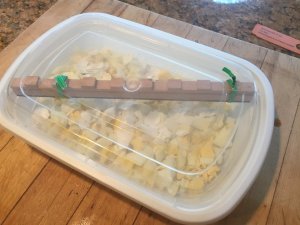
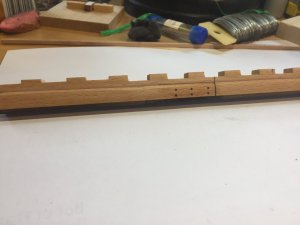
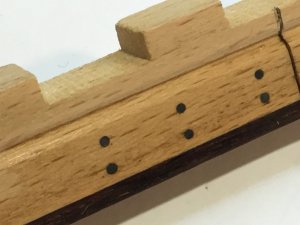
This is kind of crazy but let me explain what I did to "blacken" the copper bolts in the keel. I first tried "painting the exposed copper with Jax Black and Brass Black. The black residue that formed bled into the surrounding wood and made a mess. I sanded back to bare wood and metal and tried again. I tried painting the copper flat black, but the results were not uniformly round, and the paint looked terrible. Sanded to bare wood and copper again. The I saw something on the internet!
Hard boil, cool and peel 2 eggs. Chop up the eggs and break up the shells and layer them on the bottom of a plastic container with a tight fitting top. Secure the keel to the top with bread bag ties so the part isn't sitting on the eggs. Wait over night. You can see the results in the photo. I did put a coat of poly over the blackening so that I don't damage it or rub it off somehow. The bolts still look like metal - but used and oxidized metal! It's the sulfur in the eggs!



Strange idea, but the result looks great........I will keep this in mind.....many thanks for this egg-hint.
On the last photo we can see, that the joint in the keel is a fake one......how you did this?
On the last photo we can see, that the joint in the keel is a fake one......how you did this?
Ah, a fellow devotee to the art of details. Love the small details, Dave! Good Job!Here's my keel. I simulated scarph in the keel as shown in the AOTS drawings and used 18 gauge copper wire to simulate the bolts. Next up is blackening the copper. I'm trying a new method... hope it works!View attachment 40900
Andy
HAHA! Never thought I would see this again. I learned this back when I was kid in grammer school. Pretty cool to see someone doing this in modeling.Thanks, Mike!
This is kind of crazy but let me explain what I did to "blacken" the copper bolts in the keel. I first tried "painting the exposed copper with Jax Black and Brass Black. The black residue that formed bled into the surrounding wood and made a mess. I sanded back to bare wood and metal and tried again. I tried painting the copper flat black, but the results were not uniformly round, and the paint looked terrible. Sanded to bare wood and copper again. The I saw something on the internet!
Hard boil, cool and peel 2 eggs. Chop up the eggs and break up the shells and layer them on the bottom of a plastic container with a tight fitting top. Secure the keel to the top with bread bag ties so the part isn't sitting on the eggs. Wait over night. You can see the results in the photo. I did put a coat of poly over the blackening so that I don't damage it or rub it off somehow. The bolts still look like metal - but used and oxidized metal! It's the sulfur in the eggs!View attachment 40939View attachment 40940View attachment 40941
Thanks, guys!
Uwe: The simulated scarf was drawn out in pencil and I used a #10 X-Acto blade to score the lines. Then I ran a very thin pencil lead in the score to simulate caulking.
Uwe: The simulated scarf was drawn out in pencil and I used a #10 X-Acto blade to score the lines. Then I ran a very thin pencil lead in the score to simulate caulking.
Really nice work Dave. Better modeling through science.
- Joined
- Dec 1, 2016
- Messages
- 6,341
- Points
- 728

I really like the use of Oak it gives character to the model. Some woods have very little to no figure and you might as well be using plastic. Woods with figure and a grain pattern give the model a wood look.
nice job.
daves
nice job.
daves
Good point, Mike!
daves: The wood is actually European beech, and yes, it very much resembles oak. The difference is that the grain is finer than oak and appears more in scale. They are very similar!
daves: The wood is actually European beech, and yes, it very much resembles oak. The difference is that the grain is finer than oak and appears more in scale. They are very similar!
Dave, Looking at your build I am a RANK beginer compared to your work , but will still show my endevours a try to learn from experts, GREAT CRAFSMANSHIP. Don
- Joined
- Dec 1, 2016
- Messages
- 6,341
- Points
- 728

daves: The wood is actually European beech, and yes, it very much resembles oak. The difference is that the grain is finer than oak and appears more in scale. They are very similar!
they are very similar because Beech is an Oak they are in the same family Fagaceae.
it is hard to figure out exactly what wood is what. Actually there is no listing in any wood lists as European Beech that is a made up trade name, in Europe the wood is referred to as a species of Oak. Beech that grows in North America is exactly the same as what grows in Europe.
like Blue Beech has nothing to do with the family of Oaks it is Hornbeam so why it is sold as blue Beech is a mystery to me.
not all trees in the Oak family are created equal I think there are around 700 species that grow around the world, some have a fine grain like Beech.
at any rate I use Beech a lot because I really like the looks of it, and I do use it in 1:48 scale models.
years ago my brother a student of dendrology and I owned a tree care and removal tree service company. in the 7 years we worked together you tend to pick up information on trees. you quickly learn there are common names for trees, commercial names for trees and the real name of trees mostly in Latin. Never call a tree simply Oak there are pin Oaks, red oaks, live oaks, and an entire list of species of Oaks. The most confusing is the Acer family of trees.
notes on using wood in the Oak family
Beech has a high level of tannic acid touching metal will turn the wood black even touching the wood in time will sometimes turn the wood a dark purple. Cutting Beech on a tree job the chips and dust will react to the sweat on a T shirt and die it purple.
back in the wooden ship building days Cedar was use for timbering because it was very durable and rot resistant. Problem was copper drift pins were also used. Well the acid in Cedar rotted copper. In the long run watch out for what metals you use with different types of wood.
they are very similar because Beech is an Oak they are in the same family Fagaceae.
it is hard to figure out exactly what wood is what. Actually there is no listing in any wood lists as European Beech that is a made up trade name, in Europe the wood is referred to as a species of Oak. Beech that grows in North America is exactly the same as what grows in Europe.
like Blue Beech has nothing to do with the family of Oaks it is Hornbeam so why it is sold as blue Beech is a mystery to me.
not all trees in the Oak family are created equal I think there are around 700 species that grow around the world, some have a fine grain like Beech.
at any rate I use Beech a lot because I really like the looks of it, and I do use it in 1:48 scale models.
years ago my brother a student of dendrology and I owned a tree care and removal tree service company. in the 7 years we worked together you tend to pick up information on trees. you quickly learn there are common names for trees, commercial names for trees and the real name of trees mostly in Latin. Never call a tree simply Oak there are pin Oaks, red oaks, live oaks, and an entire list of species of Oaks. The most confusing is the Acer family of trees.
notes on using wood in the Oak family
Beech has a high level of tannic acid touching metal will turn the wood black even touching the wood in time will sometimes turn the wood a dark purple. Cutting Beech on a tree job the chips and dust will react to the sweat on a T shirt and die it purple.
back in the wooden ship building days Cedar was use for timbering because it was very durable and rot resistant. Problem was copper drift pins were also used. Well the acid in Cedar rotted copper. In the long run watch out for what metals you use with different types of wood.
Last edited:
I added the brass tubing to the keel and drilled holes in the build jig to keep the keel stationary. The Frames are dry fitted to the keel and the jig. Very small adjustments are being made with files and shimming so each frame is square and plumb. Once that's complete I'll glue and dowel the frames in place.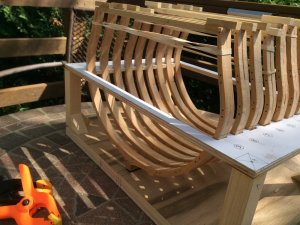
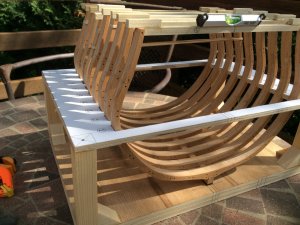


Bravo!
Very clean Dave!!
Thanks, guys!
I was concerned about how the frames were going to fit and whether fairing the "curve" in the frames moving aft was going to cause me to lose to much of the wood making up the aft-most frames. After dry fitting the frames, I found the curve to be nice and graceful and likely to require much less wood removal that I thought. Great lofting job, Mike!
The jig is a little off...especially frame #7 but that may be partially my fault in taking off too much in the depth of the notches for #7. Nothing a little shimming can't fix.
I was concerned about how the frames were going to fit and whether fairing the "curve" in the frames moving aft was going to cause me to lose to much of the wood making up the aft-most frames. After dry fitting the frames, I found the curve to be nice and graceful and likely to require much less wood removal that I thought. Great lofting job, Mike!
The jig is a little off...especially frame #7 but that may be partially my fault in taking off too much in the depth of the notches for #7. Nothing a little shimming can't fix.



